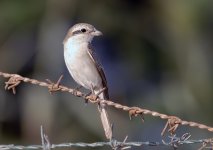AJDH
Well-known member

Here's another confusing juvenile in it's first winter plumage. My gut reaction is woodchat shrike but I'd like confirmation, one way or another.
Thanks in advance.
http://www.birdforum.net/pp_gallery/showphoto.php/photo/111504/sort/1/cat/500/page/1
Thanks in advance.
http://www.birdforum.net/pp_gallery/showphoto.php/photo/111504/sort/1/cat/500/page/1






